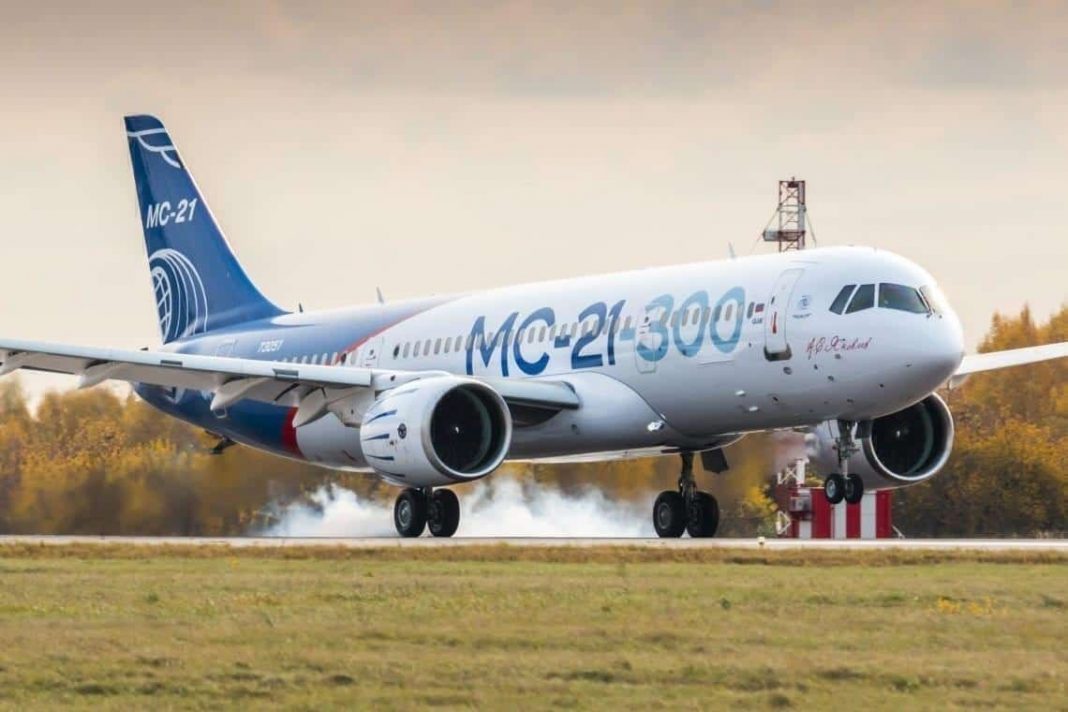Russia’s competitor to the Boeing 737 MAX and Airbus A320neo, the MC-21-300, is set to take off by the end of the year with locally made engines. The airframe has already passed flight tests and is undergoing final checks before taking to the skies with the Russian PD-14 engine.
Technically, the MC-21-300 completed its first test flight on 28 May 2017. There are four prototypes, and it has flown as far as Istanbul during the testing phase. However, these flights were all performed by the Pratt & Whitney PW1000G, found on the Airbus A320neo, Airbus A220, Mitsubishi SpaceJet, and Embraer’s second-generation E-Jets.
The United Aircraft Corporation of Russia now intends to fly the airframe with the locally made Russian Aviadvigatel PD-14 engine. The engines have been attached to the aircraft and are currently undergoing ground testing.
“Our latest event in this year will be the flight of MC-21 with the domestic PD-14 [engine]. We should complete this work by the end of the year. Engines have already been mounted on the aircraft in Irkutsk; required checks are performed at present, and the new MC-21 aircraft with the state-of-the-art PD-14 engine will take off,” Chief Executive Officer of the United Aircraft Corporation (UAC) Yuri Slyusar said on Monday at a meeting with President Vladimir Putin.
The reason why Russia is developing an engine for this aircraft from local suppliers is to ensure that they have complete control over the supply chain. Not only to prevent delays in the order (imagine if something were to go wrong with the production line, they would be competing with Airbus), but to offer a locally made alternative that supports the native industry.

Why is Russia building the MC-21?
As the aviation industry grows (ignoring the events of this year), there will be demand for more aircraft in the 150-200 seater range (such as the Boeing 737-800). However, order backlogs in both the Airbus A320neo and the Boeing 737 MAX production lines mean that some airlines who order today may not get the aircraft for many years.
Thus, there is a potentially lucrative market for the MC-21, especially around the Russian sphere of influence. Aeroflot, the national carrier of Russia, is backing the aircraft with an order for 50 MC-21 jets and an additional option for 35 more.
“[Aeroflot will buy] 200 domestically produced SSJ 100 and MC-21 airplanes should become operational by 2026, the fleet should amount to approximately 520 airplanes to deliver the target passenger traffic,” Aeroflot said to TASS.

How does it compare to the Boeing 737 MAX and Airbus A320neo?
If we were to put the MC-21-300 next to the Boeing and Airbus equivalents, what would it look like?
- The MC-21-300 can fly up to 211 passengers in a high-density configuration (28 inches seat pitch) to a range of 6,000 km (3,200 nautical miles).
- The Airbus A320neo can fly 195 passengers in a crushing high-density configuration (27 inches seat pitch) to a range of 6,500 km (3,500 nautical miles).
- The Boeing 737 MAX 8 can fly 200 passengers (28 inches seat pitch) to a range of 3,550 nautical miles (6,570 km).
Thus you can see that the MC-21 fits very snuggly into the same market category as the others and is a worthy alternative for airlines looking to buy near Russia. There is some concern about maintaining the aircraft (such as what happened when Interjet ordered SSJ100) but as the aircraft isn’t out on the market we can’t speculate.
What do you think? Will you fly on the MC-21-300? Let us know in the comments.
[ad_2]
Source link


